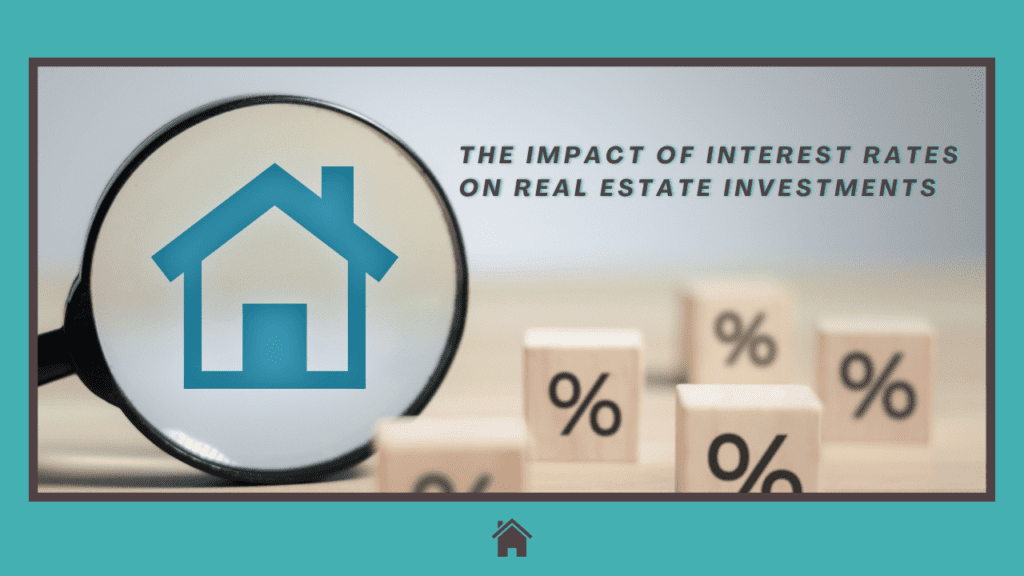
All indications point to an easing of inflation, but the interest rates have been slow to fall. We can hope that the Federal Reserve will usher in a rate cut to offset the historically high rates we’ve been dealing with for over a year now.
Interest rates are higher than they’ve been in 23 years. What does that mean for your real estate investments? It’s more than pricey mortgages. It means all kinds of debt is more expensive. If you have to finance a remodel or put some new appliances for your rental units on a credit card, you’re paying more thanks to those higher interest rates.
Real estate investments are often seen as a stable and lucrative way to build wealth over time. However, one crucial factor that can significantly influence the success of these investments is the fluctuation of interest rates.
Let’s take a look at the impact of interest on real estate investments, and how you can best position yourself in a market that may be strong but is also more expensive.
Understanding Interest Rates as an Investor
You likely understand the basics of interest rates, but how do they impact your real estate?
Let’s refresh.
Interest rates represent the cost of borrowing money and are typically expressed as a percentage of the loan amount. Central banks, such as the Federal Reserve in the United States, set benchmark interest rates that influence the rates offered by commercial banks and other lenders. These rates can fluctuate based on economic conditions, inflation, and monetary policy decisions. So, while mortgage rates themselves might not be going up, the rising interest rates establish a higher benchmark against which mortgage rates are set.
Historical Trends in Interest Rates
Looking at the way interest rates have impacted economies and markets in the past can help us understand where we are today and where we’re likely to be going. Historical trends in interest rates reveal a necessary relationship between economic cycles, inflation, and monetary policies.
Over the decades, interest rates have experienced periods of both sharp rises and significant declines. These are often notable periods in history. For example, during the early 1980s, the United States witnessed some of the highest interest rates in history as the Federal Reserve aggressively tightened monetary policy to combat widespread inflation that was driving up the cost of gas, housing, food, and just about all consumer goods. These high rates made borrowing costly and significantly impacted real estate investments by reducing liquidity and increasing mortgage payments.
And on the opposite end of the inflation spectrum, we can look at the early 2000s, a period of time that saw a prolonged period of low interest rates aimed at stimulating economic growth in the aftermath of the dot-com bubble burst and the 2008 financial crisis. These lower rates made borrowing more affordable, spurring an increase in real estate investments and development.
And then, more recently, in response to the COVID-19 pandemic, interest rates were once again slashed to historic lows to provide economic support, leading to a booming housing market as many sought to take advantage of cheaper financing. We’re now in the process of a re-set, and that has meant historically high interest rates that the Fed will eventually lower. For right now, though, we’re all feeling the pain.
Understanding these historical trends is vital for real estate investors, as historic patterns can provide valuable insights into how future changes in interest rates might impact the market. By analyzing these trends, investors can better anticipate the potential effects of interest rate movements and adjust their strategies accordingly.
Analyzing Connections Between Interest Rates and Real Estate Investments
As you make decisions about whether to buy, sell, diversify, improve, or just hold steady, you’ll want to gather these insights about the connections between interest rates and your property.
- Mortgage Rates
One of the most direct ways interest rates impact real estate investments is through mortgage rates. When interest rates rise, the cost of borrowing increases, leading to higher mortgage rates. This can make financing real estate purchases more expensive, potentially reducing the affordability of properties for buyers. Maybe it’s a good time to pay in cash if you have it.
Conversely, when interest rates decline, mortgage rates tend to follow. Lower mortgage rates can stimulate demand for real estate by making loans more affordable and attractive to potential buyers. This increased demand can drive up property prices, creating a favorable environment for real estate investors.
- Property Values
Fluctuating interest rates can also affect property values. When interest rates are low, homebuyers can afford larger loans, which can lead to increased demand for properties. This heightened demand often results in rising property values, benefiting real estate investors who own properties during these periods.
But, as we noted, with higher interest rates, the cost of borrowing increases, reducing the purchasing power of potential buyers. This can lead to decreased demand for properties and, consequently, lower property values. Real estate investors may need to adjust their strategies in response to these market conditions.
- Investment Strategies
Interest rates can influence the strategies real estate investors employ to achieve their financial goals. In a low-interest-rate environment, you may be more inclined to pursue aggressive growth strategies, taking advantage of cheap financing to acquire properties and expand their portfolios.
In contrast, during periods of high interest rates, conservative investment approaches may be better advised. You might focus on properties with strong cash flow potential to ensure stable income streams that can cover higher financing costs. Additionally, refinancing existing properties to lock in lower interest rates before further increases can be a strategic and smart move.
- Rental Income and Cash Flow
For real estate investors who rely on rental income, interest rates can impact cash flow. When interest rates rise, the cost of servicing mortgage debt increases, potentially reducing your net rental income. Investors need to carefully evaluate their rental yields and operating expenses to ensure positive cash flow, even in a high-interest-rate environment.
But, during periods of low interest rates, you might find that you’re earning more thanks to lower financing costs. You will potentially increase your net rental income and overall cash flow. Always monitor market conditions and make necessary adjustments to rental rates to stay competitive.
The Influence of Interest Rates on Residential Real Estate
Interest rates play a pivotal role in shaping the residential real estate market. The cost of borrowing directly affects home buyers’ purchasing power and the overall affordability of housing.
- Homebuyer Affordability
Are you planning to buy a home for yourself or as an investment? Ideally you’ll buy while interest rates are low. This will give you more money to spend as you approach the market. It will also give you a less expensive mortgage to pay back.
- Housing Market Demand
Low interest rates generally stimulate demand in the housing market. Cheaper borrowing costs make homeownership more accessible to a broader range of buyers, including first-time buyers and those looking to upgrade to larger properties. This increased demand can lead to a competitive housing market, with bidding wars becoming more common. On the flip side, rising interest rates can cool down an overheated market by deterring potential buyers due to increased financing costs.
- Refinancing Opportunities
Interest rates have a huge impact on refinancing.
Fluctuations in interest rates will historically affect the propensity of homeowners to refinance existing mortgages. When those rates dropped in the 2000s, everyone was refinancing out of their more expensive mortgages into more affordable loans. We can expect the same thing when rates finally drop later this year and hopefully into next year.
When interest rates decline, homeowners can secure lower monthly payments or shorten the loan term, thus saving on interest payments over time. This trend can lead to a surge in refinancing activities, benefiting both borrowers and lenders.
- New Constructions and Developments
The construction of new residential properties is sensitive to interest rate changes as well. Lower interest rates reduce the cost of financing for developers, encouraging new housing projects and residential developments. This can lead to an increase in the supply of homes within the market. In contrast, higher interest rates raise the cost of development loans, potentially slowing down the pace of new constructions. Developers may become more cautious and defer building projects until interest rates become more favorable.
Understanding the influence of interest rates on residential real estate helps investors, developers, and policymakers make informed decisions to navigate the housing market. By staying attuned to interest rate trends, you can better anticipate market shifts and strategize effectively.
This is our hot take on Interest rates and the significant role they play in the real estate investment landscape. They can impact mortgage rates, property values, investment strategies, and cash flow. As an investor, it is in your best interests to be aware of these dynamics and adapt your strategies accordingly.
 Evaluating current market conditions and closely monitoring interest rate movements is what we do as local property management and real estate experts. Let’s talk about what it means for you and your portfolio specifically. Please contact us at Anchor Down Real Estate & Rentals.
Evaluating current market conditions and closely monitoring interest rate movements is what we do as local property management and real estate experts. Let’s talk about what it means for you and your portfolio specifically. Please contact us at Anchor Down Real Estate & Rentals.
